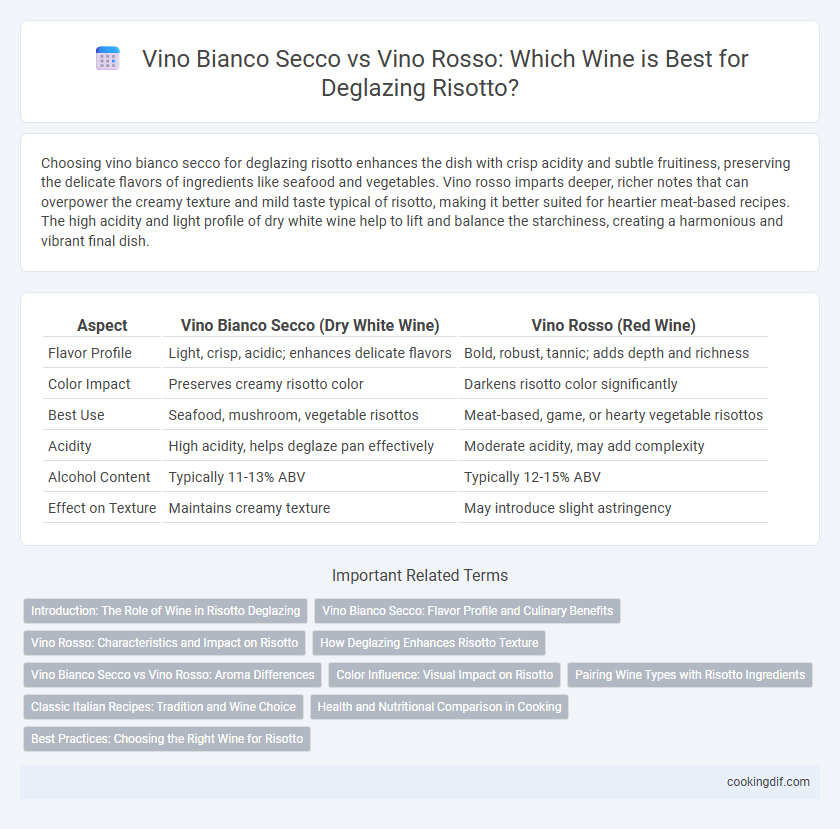Choosing vino bianco secco for deglazing risotto enhances the dish with crisp acidity and subtle fruitiness, preserving the delicate flavors of ingredients like seafood and vegetables. Vino rosso imparts deeper, richer notes that can overpower the creamy texture and mild taste typical of risotto, making it better suited for heartier meat-based recipes. The high acidity and light profile of dry white wine help to lift and balance the starchiness, creating a harmonious and vibrant final dish.
Table of Comparison
| Aspect | Vino Bianco Secco (Dry White Wine) | Vino Rosso (Red Wine) |
|---|---|---|
| Flavor Profile | Light, crisp, acidic; enhances delicate flavors | Bold, robust, tannic; adds depth and richness |
| Color Impact | Preserves creamy risotto color | Darkens risotto color significantly |
| Best Use | Seafood, mushroom, vegetable risottos | Meat-based, game, or hearty vegetable risottos |
| Acidity | High acidity, helps deglaze pan effectively | Moderate acidity, may add complexity |
| Alcohol Content | Typically 11-13% ABV | Typically 12-15% ABV |
| Effect on Texture | Maintains creamy texture | May introduce slight astringency |
Introduction: The Role of Wine in Risotto Deglazing
Vino bianco secco enhances risotto by adding vibrant acidity and subtle fruit notes that brighten the dish during deglazing. Vino rosso introduces deeper, robust flavors and a richer color, creating a more intense base for heartier risotto varieties. Choosing between these wines depends on desired flavor profiles and complements the overall ingredient harmony in the risotto.
Vino Bianco Secco: Flavor Profile and Culinary Benefits
Vino Bianco Secco offers a crisp acidity and subtle fruity notes that enhance the delicate flavors of risotto without overpowering its creamy texture. Its light, refreshing profile balances the richness and allows rice grains to absorb nuanced aromas during deglazing. Using Vino Bianco Secco promotes a harmonious blend of flavors, elevating traditional risotto dishes with complexity and brightness.
Vino Rosso: Characteristics and Impact on Risotto
Vino Rosso, characterized by its robust tannins and deep berry flavors, imparts a rich complexity when used for deglazing in risotto preparation. Its bold acidity enhances the risotto's creamy texture while contributing layers of earthy and fruity notes, elevating the overall depth of the dish. Choosing Vino Rosso over Vino Bianco Secco intensifies the flavor profile, making it ideal for heartier risotto variations featuring mushrooms, beef, or game.
How Deglazing Enhances Risotto Texture
Deglazing with Vino Bianco Secco imparts a bright acidity that lifts the risotto's creamy texture while preserving its delicate flavors, enhancing the rice's starch release for optimal creaminess. In contrast, using Vino Rosso introduces deeper tannins and robust fruity notes that can slightly mask the risotto's subtle texture but adds complex layers to the dish. The choice between white and red wine for deglazing directly influences the balance between risotto's silkiness and flavor intensity, shaping the final mouthfeel and aromatic profile.
Vino Bianco Secco vs Vino Rosso: Aroma Differences
Vino Bianco Secco enhances risotto by imparting bright citrus and floral aromas that complement the creamy texture without overpowering delicate flavors. In contrast, Vino Rosso introduces deep, fruity, and earthy notes, which can dominate the subtlety of traditional risotto, making it more suitable for heartier, robust dishes. Choosing Vino Bianco Secco for deglazing preserves the risotto's balanced aroma profile while maintaining a clean, vibrant finish.
Color Influence: Visual Impact on Risotto
Vino Bianco Secco enhances risotto by maintaining its creamy, pale appearance, preserving the dish's classic visual appeal and allowing the natural colors of ingredients like saffron or mushrooms to stand out. Vino Rosso imparts a richer, reddish hue that can significantly alter the risotto's traditional look, creating a more rustic and bold presentation. The choice between white and red wine for deglazing directly influences the risotto's color palette, impacting both aesthetic perception and the dining experience.
Pairing Wine Types with Risotto Ingredients
When deglazing for risotto, Vino Bianco Secco complements delicate ingredients like seafood, asparagus, and lemon by enhancing their subtle flavors without overwhelming them. Vino Rosso pairs well with robust risotto variations featuring mushrooms, beef, or rich tomato-based sauces, adding depth and balancing earthy or hearty components. Selecting the appropriate wine for deglazing intensifies the risotto's overall flavor profile and harmonizes the dish's complexity.
Classic Italian Recipes: Tradition and Wine Choice
Classic Italian risotto recipes traditionally use Vino Bianco Secco for deglazing, as its crisp acidity enhances the delicate flavors without overpowering the dish. Vino Rosso, with its richer tannins and bolder profile, is less commonly chosen, often reserved for heartier or meat-based risottos. Choosing the appropriate wine ensures the perfect balance of aroma and taste, preserving the authentic character of Italian culinary heritage.
Health and Nutritional Comparison in Cooking
Using vino bianco secco for deglazing in risotto enhances flavor with lower tannins and fewer antioxidants compared to vino rosso, which contains higher levels of polyphenols and resveratrol linked to cardiovascular benefits. Vino rosso's richer antioxidant profile may contribute to better heart health, but its stronger flavor can dominate delicate risotto dishes. Choosing vino bianco secco supports a lighter flavor balance and offers moderate nutritional advantages while aligning with lower calorie and acidity preferences in cooking.
Best Practices: Choosing the Right Wine for Risotto
Using vino bianco secco for deglazing risotto provides a clean, crisp acidity that enhances delicate flavors like seafood or vegetable-based risottos. Vino rosso imparts richer, deeper notes ideal for heartier dishes with mushrooms, beef, or game, adding complexity without overpowering the rice. Optimal selection depends on desired flavor profile and pairing, but dry white wine remains the classic choice for achieving balance and maintaining risotto's signature creaminess.
Vino Bianco Secco vs Vino Rosso for Deglazing Infographic

 cookingdif.com
cookingdif.com